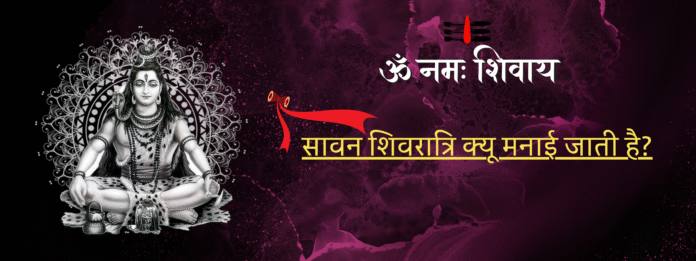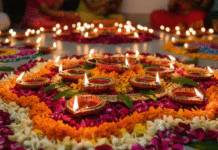Sawan, or Shravan, in Hinduism, bears great spiritual significance, particularly for devotees of Lord Shiva. The Sawan month is filled with various auspicious days, and the crowning event that marks the glory of the day is Sawan Shivratri celebrated with a lot of devotion and ceremonies. This article explores the spirit, significance, associated rituals, and distinctive customs such as Kanwar Yatra which enliven this celebration across the entire subcontinent. If you are a spiritual person or are just curious, this Sawan Shivratri 2025 guide will take you upon an engaging journey into this sacred event.
What is Sawan Shivratri and Its Significance in India?
Sawan Shivratri is a special night dedicated to Shiva, a festival celebrated in the month of Sawan (July-August). Given that it is celebrated during the monsoon, it is nowhere near as famous or celebrated as Maha Shivratri (celebrated in February-March) with its celebration coinciding with the phases of the lunar calendar. While late July to early August in 2025 is the date expected for Sawan Shivratri, such a date is awaited by the devotees just to pay homage to Lord Shiva.
That brings us to the meaning of Sawan Shivratri-a very spiritually meaningful one. People are of the opinion that worshiping Lord Shiva on that night brings blessings and fulfills one’s desires and obstacles that one faces in life. The devotees therefore find it opportune to connect with the divinity they see there to seek forgiveness, prosperity, and spiritual growth. Moreover or even more so temples breathe with life and prayers in India from millions of devotees, making that night a true crown jewel in the culture of Hinduism.
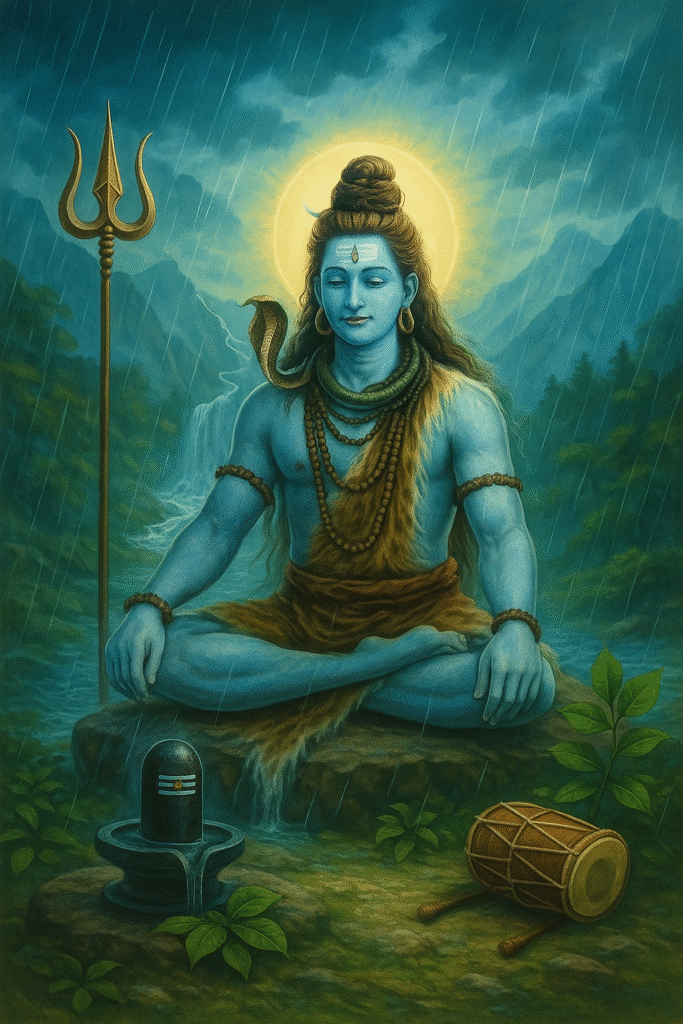
Importance of Sawan Month in Hinduism
The Sawan month is one of the holiest times in the Hindu calendar, as it concerns Lord Shiva. It arrives with renewed growth due to monsoons, and the rains make the earth feasible after the biting summer. As for the devotees of Shiva, Sawan becomes an added significance in the sense that it is believed that the Lord Shiva drank poison during a time when the ocean was churning (Samudra Manthan) in order to save all beings, thus was given the name Neelkanth (meaning blue-throated).
Throughout the month of Sawan, devotees deprive themselves of food, visit shrines, and chant hymns. Sawan Mondays or Sawan Somvar are the most important days when devotees fast and pray. Thus, within Sawan, all possible acts of devotion culminate during the festival of Sawan Shivratri, making it a well-loved time towards spirituality and devotion towards Lord Shiva.
Who Are Kanwariyas and the Significance of the Kanwar Yatra?
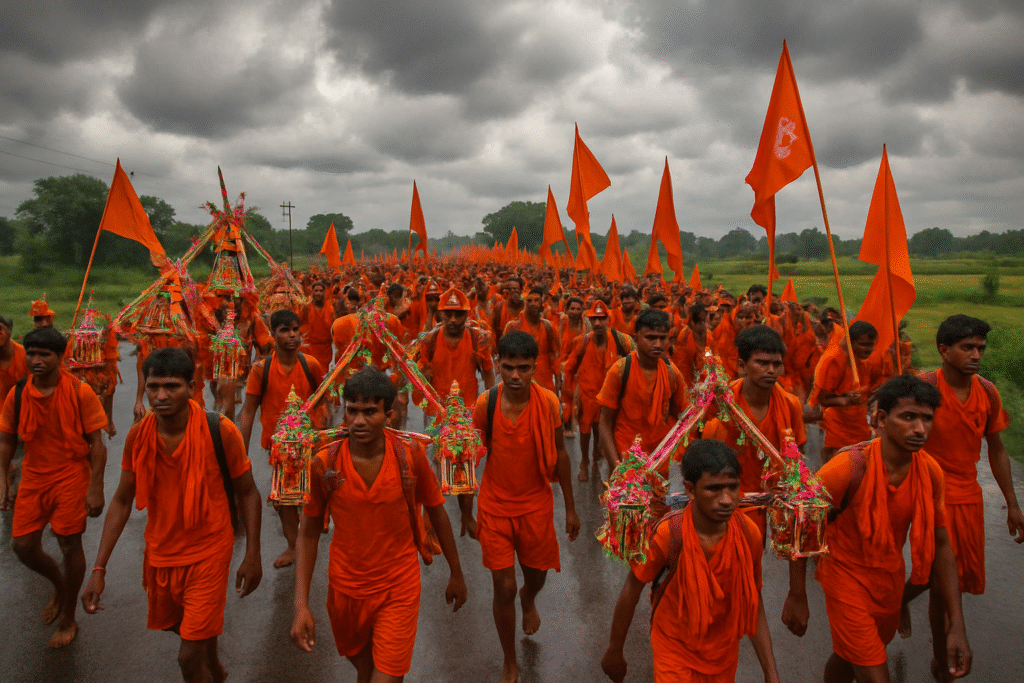
One of the most important features of Sawan is the Kanwar Dham Yatra pilgrimage, celebrated by devoted Kanwariyas. These ardent devotees travel barefoot without any hindrance, sometimes even hundreds of miles, carrying beautifully decorated wooden sticks known as “Kanwars,” having pots of holy water from the Ganga, theoretically under saffron dress, and finally deliver holy water to a temple dedicated to Lord Shiva in solemn cities like Haridwar, Varanasi, and Devghar.
The Timing of the Journey
The Kanwar Dham Yatra begins with the commencement of the Sawan month, which generally runs between the months of July to August in the Hindu lunar calendar. This is an important timing with respect to the belief that during this month, Lord Shiva receives the highest devotion. In Hindu mythology, this is the month during which Lord Shiva drank the poison that was churned out of the ocean in order to salvage the entire universe; therefore, he was called Neelkanth (the blue-throated one). This pilgrimage of the Kanwar Yatra coincides with this holy time, thus increasing its spiritual importance.
The Significance of the Kanwar Yatra
The Kanwar Dham Yatra begins with the onset of the month of Sawan, which typically occurs between July and August according to the Hindu lunar calendar. This is the time believed to be most favorable for worship by Lord Shiva, according to the faith. The month during which Lord Shiva drank the poison churned from the ocean to save the entire world is well known because the month gave him the name Neelkanth (blue-throated). This pilgrimage of the Kanwar Yatra coincides with this holy time, thus increasing its spiritual importance.
Why and How Sawan Shivratri is Celebrated
Sawan Shivratri, in all its splendor and devotion, weaved together millions in prayer. They begin their journey very early in the morning with holy bathing in rivers like Ganga and then proceeding for worship either in temples or at home. An atmosphere of reverence and joy is created by welcoming Lord Shiva with pujas, bhajans, and fasting rules.
Key Rituals of Sawan Shivratri
● Abhishekam: The worshippers perform ceremonial bathing of the Shiva Lingam with substances like milk, honey, curd, and Ganga water, symbolizing purification and devotion.
● Fasting: Most keep a fasting from every kind of food and drink. They mentally prepare themselves through the entire month of Shravan with fruits and milk. This fasting is seen as purification of the body and the soul.
● Offerings: Offerings such as bilva leaves, flowers, and fruits are presented to Lord Shiva, with special emphasis on bilva leaves due to its holiness.
● Pujas and Mantras: The evening pujas comprise chanting “Om Namah Shivaya” and various other mantras while lighting lamps to dispel ignorance.
The temples, while special functions are conducted, the ambience comes alive at home with bhajan singing. The day is then interlaced with the serious rituals and sharing, maintaining the emotive aspect of the day and showing the oneness of Shiva Bhaktas.
Details About Lord Shiva, Fasting, Rituals, and Devotional Practices
Who is Lord Shiva?
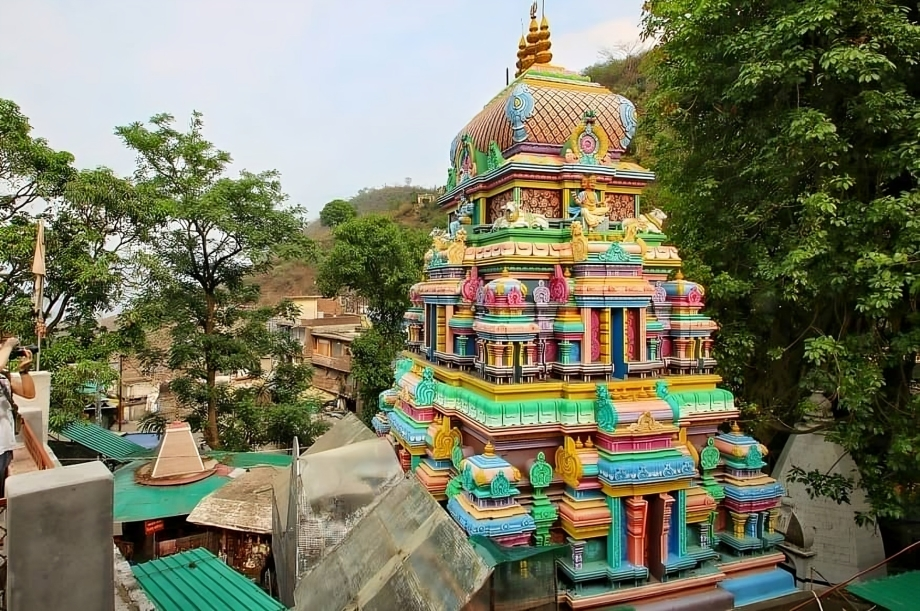
Must be the Destroyer and Transformer of the Universe, along with Brahma and Vishnu as part of the Hindu trinity. Even so, he is often called an ascetic, because depictions of him commonly include a third eye, a crescent moon upon his head, and a snake around his neck. In Mount Kailash and Neelkanth, his name indicates immense power but also immense compassion. Thus, devotees worship him because through him moksha would be able to give to the world instead of turning it into chaos.
Fasting on Sawan Shivratri
Fasting forms the basis of Sawan Shivratri. Disciplines and total surrender to the Lord in selflessness are what such fasts mean. Nirjala fasts are undertaken by some, while others engage lighter fasts with fruits and dairy. The belief here is that this fast purifies the mind, reduces ego, and invites the grace of God. In fact, an individual commitment to spiritual growth is strengthened through this.
Rituals and Their Meaning
● Abhishekam: Besides cleansing, it expresses the flow of devotion towards Shiva.
● Bilva Leaf Offerings: These three-pronged leaves represent the trinity and Shiva’s
omnipresence.
● Reciting Mantra: In short, it is the one primary form through which one’s body communes with the energy manifested by Shiva, and by such invocation, peace and focus are fostered.
● Lamp Lighting: A symbol of enlightenment, it denotes inner darkness removal.
Devotional Practices
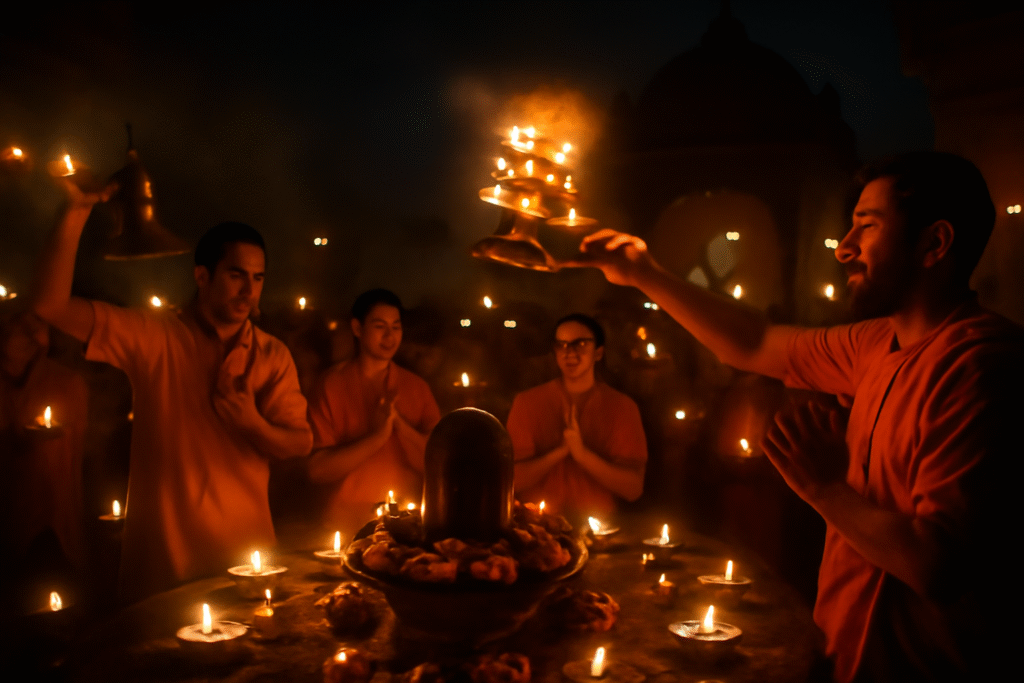
Expressing love for Shiva translates into additional practices such as
● Singing Bhajans: The air is suffused with melodious phrases that glorify Shiva,
inculcating a festive characteristic to the environment.
● Meditation: Standing in his least-perfect qualities in power, compassion, and
detachment for personal transformation.
● Scripture Reading: Texts like the Shiva Purana deepen understanding of his divine
role.The reading in sacred texts like the Shiva Purana helps them appreciate his
divine role.
These acts of worship in the context of Sawan Shivratri make it celebratory as well as introspective.
Why Sawan Shivratri Matters Today
The month of Sawan is devoted to the celebration of Shivaratri, which gives time for the self-relation of the fast-paced person to eternal values such as faith, resilience, and gratitude. This holy day verily stands as a monument, showing that beyond all things, this event of life holds much account-and a fasting experience that everyone is loyal to in honouring the incomparable sacrifices of Lord Shiva at Samudra Manthan. As a protection against the deadliest poison that resulted from the churning of the ocean-the annihilation of the universe-lord Shiva made a great sacrifice by consuming the poison, keeping it in his throat to protect humanity. This act earned him the name Neelkanth, which means the blue-throated one, Lord Shiva swallowed poison and suffered incredible pain for the good of the universe. In honour of this sacrifice, devotees conduct abhishekam to him in order to cool him with such offerings as milk, water, and honey. This further symbolizes their devotion to Lord Shiva and an opportunity of cooling him down from the scorching heat endured after he consumed the poison.
Carrying holy water naked for such long distances teaches patience and disciplined fasting in the start of the Sawan yatra. The rites of Abhishekam speak about a deeper meaning of life and the significance of selfless service. For millions of devotees, Sawan Shivratri means a time to invoke blessings of health, happiness, and harmony from Lord Shiva in recognition of these blessings already existing within man.
Sawan Shivratri 2025, The particular day remains superiorly inspiring. Whether you would join the Kanwariyas on their journey or fast at home, or even simply learn about this tradition, this special day invites all into the spiritual richness of Sawan Shivratri. It is the glory of Lord Shiva’s grace that will last forever-a reminder that amidst all hurricanes of life, he acts as a constant beacon in love and protect.



